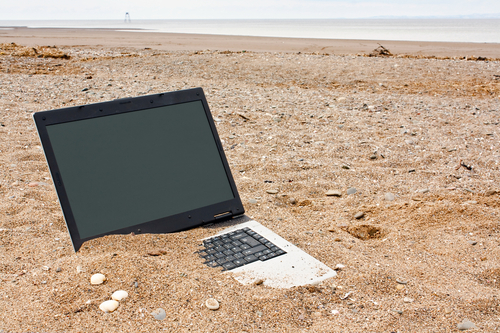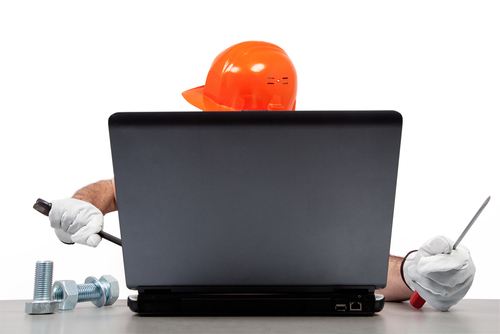November 18th, 2013

Computers aren’t cheap and most of us see a decline in performance of our current PC before we’re ready to invest in a new one. A post at IT Manager Daily contains some suggestions for how to improve the performance of older computers to prolong their life. Whether you want to get more out of your personal laptop, or don’t have the budget for new computers at your business, these are valuable tips.
If your PC is a couple years old, you’ve probably downloaded files and applications you don’t need. You’ve probably also encountered malware, adware or spyware that is still on your hard drive. There are tools available to do a complete scan of your system and help you remove unwanted and unnecessary files. Once you also remove the files and programs you no longer want or need, be sure to run Defrag, or defragmentation. This reorganizes data stored on your hard drive to make it more efficient. Over time, fragmentation occurs when files are saved and deleted.
At this point, you should have deleted everything that isn’t vital on your machine. Take what’s left and back it up on an external hard drive or another storage device. This is to make sure nothing is lost through the rest of the process.
New hardware, like a memory upgrade, is much cheaper than an entire new computer, but will significantly improve performance. Do some research or ask a professional about which upgrades will boost your machine’s performance the most.
With everything backed up, you can start over from scratch. Re-install your operating system, or take this chance to upgrade to one with better performance. Be sure to check for updates that you may have failed to install before. These updates often solve stability issues that could be slowing down your machine.
Once you’re back up and running, be smart about what you save on your hard drive to keep it running smoothly for longer. Use cloud storage so you don’t have to save directly to your hard drive. Keep security software updated and running to keep viruses and malware from infecting your system. Regularly go through your files and delete those you no longer need.
If you need help upgrading hardware, installing a new operating system, backing up data or removing viruses and malware, bring your computer in to Geek Rescue, or call us at 918-369-4335.
November 12th, 2013

When you purchase a new computer, you’re probably expecting it to last for a few years before having to replace it. But how long can you realistically expect it to last? Brian Beach, of Backblaze, writes that they’re researching the average life expectancy of hard drives so you can have realistic expectations for your devices.
Before diving into the numbers of the study, it’s important to understand the hard drives being examined and how they’re being used. Backblaze tried using consumer-grade, internal hard drives, which would be the same as you would find in your PC. They ran into a shortage of these types of hard drives, however, so some are from external units. That could arguably alter some of the data found in their study, but considering there are more than 25-thousand drives involved, it likely won’t make that much difference.
Though the drives used are similar to what you’d find in your computer, they’re not used exactly the same way you use yours. Backblaze’s hard drives are kept spinning at all times. They’re used in data centers so there’s never any down time. So, their life expectancy is in time of use. If a hard drive is expected to “live” for four-years, that’s not four-years from purchase, but rather four-years of use, which in your PC could be closer to ten years from purchase.
There are three distinct phases of a hard drive’s life. In the first phase, which is the first 18-months of life, five-percent of hard drives are expected to fail. These are mostly drives with a factory default that cause them to break.
In the second phase, which extends to the three-year mark, hard drives actually fail less. During this second phase, the average fail rate is only about 1.4-percent. In this phase, the factory defects have all been weeded out. The failures that are seen are attributed to random failures, which are freak accidents that can’t be planned for or avoided.
The third phase begins at the three-year mark and contains the highest failure rates. Up until year five, failures hover between about 10-percent and 18-percent. This is where Backblaze’s data ends. They’ve only been monitoring hard drives for four years, but speculation says year five marks another increase in failure rate.
- How long will your drive last?
This research seems to suggest that any hard drive you purchase has a chance of breaking at any time, with the chances increasing significantly after three years. That’s true, but overall 80-percent of hard drives last for at least four years. An informed estimation is that at least half of hard drives will survive for six years.
Remember that this is referring to time of constant use. If you’re fortunate enough to buy a hard drive that will last more than six years of use, you’ll likely have no problems with it before you’re ready to buy another computer.
The threat of a hard drive failing is constant, however. One in five won’t make it to year four. Unfortunately, there’s no user practices that can extend the life of your hard drive. It’s just blind luck whether yours lasts or doesn’t, assuming you aren’t being unnecessarily hard on it. That underscores the importance of backing-up your files. Given that your hard drive could fail at any time, using your hard drive as a storage option isn’t as reliable as you might think. Instead, be sure to explore other storage options before your hard drive crashes so you’re not left with nothing.
Geek Rescue offers a number of storage options and we also fix hard drives. We’ll recover lost data and get you back up and running in no time. Bring your broken devices in to on of your locations or call us at 918-369-4335 today.
September 4th, 2013

If you own a computer, or any device really, you’re likely to encounter problems from time to time. But, as Ben Kim of CIO points out, some of the more common problems have easy fixes that you can handle yourself.
Regardless of the problem and before you try anything else, restart your computer. There’s a reason this is cliched advice. For many issues, a restart will put everything right.
Your system will slow down when your hard drive gets too full. If you’ve noticed a sluggish performance, try clearing some space. Windows users will also want to use Microsoft’s System Configuration tool to trim down the number of applications that open automatically on start-up. To access it, press Windows-R, type “msconfig” and hit Enter.
If your downloads are taking longer than they should, test your connection speed. You can do this on a number of websites. Resetting your modem and router is also a good idea before contacting your Internet Service Provider.
If you’re seeing a high number of pop-ups ads, you’ll want to make sure you have a pop-up blocker enabled in your browser. If they appear when you aren’t even surfing the internet, you’ve got adware. This usually stems from you installing a program that had adware hidden in it. To remove it, try running any security software you may have, or installing new adware-specific programs.
If you’re sitting in range of your wireless router, but you still get a weak signal or constant disconnects, there are a couple of fixes. First, try resetting the modem and router. Then, let Windows troubleshoot the problem for you by right-clicking on the Wi-Fi icon in the taskbar and selecting ‘Diagnose Problem” or “Troubleshoot Problems”.
We’ve all had our share of printer-related headaches. Check to make sure there’s enough ink, toner and paper and the notification light isn’t blinking. Turn the printer off, then back on. You can even completely unplug the power supply and wait a few seconds before plugging it back in. If you still can’t print, check to see if the “Use Printer Offline” option is enabled. Windows will switch this automatically in some circumstances so make sure to uncheck it.
If these fixes don’t work or you have a more serious issue, call Geek Rescue at 918-369-4335. Our team of techs fix any problem your device may have. Give us a call, or bring your device to one of our convenient locations.
August 30th, 2013

Windows 8 offers users a unique password option when users sign in. Rather than a text password, users are able to use an image from the Pictures folder to keep their PC secure. Although this is an interesting idea that personalizes a user’s device, it is proving to fail in the security department.
As Thomas Claburn reports for Information Week, a group of researchers created a method for breaking the Windows 8 picture passwords. Their model was successful in hacking a password 48-percent of the time during one test.
To set a picture password, users choose an image, then draw circles, lines or tap different places on the image. When they log-in, they just need to take the same actions in the same order. It’s similar to smartphones that lock with a pattern, rather than a pass code.
Windows 8 does take some precautions to make this method more secure. Most notably, a user is limited to 5 log-in attempts. After a fifth failed attempt, the device is locked down. This means hackers can’t launch a purely automated attack, or brute force attack, that tries every combination possible. During testing, a purely automated attack was only successful about 1-percent of the time.
That is still a significant number of users at risk, and researchers suggested that a higher success rate is likely with a little training. Beyond the technical capabilities of picture passwords, what makes them insecure is how most people use them. When manipulating an image, most people will circle, or tap the eyes and draw a line on the mouth. These tendencies make it much easier for a password to be hacked.
What’s lacking from picture passwords is a strength meter. When you make a password for an online account, most sites will tell you if the password is strong, weak or unacceptable. Windows 8 included no such meter for picture passwords.
Since this is a new log-in method for most people, users won’t know what a strong picture password consists of. A password meter could help ensure that users have a password strong enough to hold up to a hacking attempt.
To keep your machine more secure, contact Geek Rescue at 918-369-4335. We have a variety of security solutions to keep you safe.
August 20th, 2013

Chances are, you use a touchscreen every day. Whether on your smartphone or a tablet, we tend to take the technology for granted. Have you ever considered how that touchscreen works?
Ian Rodricks wrote about the three “vital components” in every touchscreen for IndiaNIC.
You see that clear, glass panel on your phone or tablet? It’s not the display screen, but rather the touch sensor. The display screen lies behind it. The sensor uses electrical signals that are altered when you touch the screen. This is how it determines where and how the touch occurred.
The touch controller translates your actions on the touchscreen and turns it into data the PC understands. So, when you pinch to zoom, the touch controller relays that message to the PC and you see your display zoom.
The PC and the controller speak the same language because of the software driver. The driver tells the PC how to interpret the signals sent from the touch controller. Usually, the driver used is like the mouse driver in a desktop PC. This way, your finger on the touchscreen acts like the mouse pointer moving across your home PC screen.
Touchscreens are incredibly easy to use, but have only been affordable for mass produced devices for the past several years. Unfortunately, they are sensitive and fragile.
If you’re having trouble with a touchscreen device, call Geek Rescue at 918-369-4335. We fix smartphones, tablets, mp3 players and more.
August 19th, 2013

An estimated 90-million tablets will be sold this year and that number is expected to grow steadily to about 140-million in only two years time. Does this mark the end of the desktop and laptop PC?
As Scott Finnie reports for CIO, PCs don’t seem to be going away anytime soon. In fact, PC sales increased almost five-percent over the past year.
The tablets main weakness is its lack of a keyboard. That makes typing anything longer than a web address or short email difficult. Particularly for business use, this makes adopting tablets in favor of PCs, rather than in addition to them, nearly impossible.
While Finnie argues that tablets will eventually overtake PCs and render them obsolete, the clear conclusion, at least for the time being, is that the two will co-exist. The tablet doesn’t offer any functionality that can’t also be performed by a PC. The PC, however, does have some offerings that the tablet can’t do, or at least can’t do easily.
The tablet, however, offers much better portability, even more than a typical laptop. As more businesses increase their need for mobile devices, the need for tablets also grows.
The tablet is mobile and many times are more affordable than a PC. So far, that doesn’t mean that your PC will soon be a thing of the past.
Whether you’re using a tablet or a PC, call Geek Rescue at 918-369-4335 for support. We repair all devices and fix broken and cracked screens, clean viruses and malware and much more. Whatever the problem with your device, we fix it. Like we always say, if it boots up or turns on, we’ve got you covered.
















